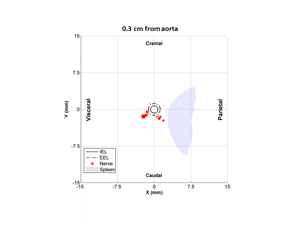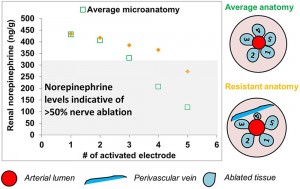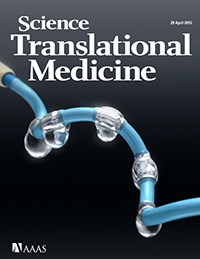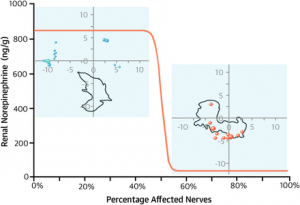FOCUS ON SYMPATHETIC DENERVATION
CBSET's approach to the study of Sympathetic Denervation technologies
The last decade has witnessed intense research into minimally invasive sympathetic denervation therapies — from catheter-based drug delivery systems to sonic and RF ablation devices — to treat chronic diseases such as systemic hypertension, metabolic syndrome, sleep apnea, heart failure, liver cirrhosis and rheumatoid arthritis.
Since the inception of this technology, CBSET has led the way in developing animal models for assessing safety, as well as quantitative methods for assessing and understanding efficacy, including biomarker assays, histomorphometry, and even computational modeling. CBSET is a recognized key opinion leader in the evaluation of neuroablation technologies. We have coauthored the leading consensus paper on the preclinical evaluation of denervation devices, and our scientific publications have been editorialized by the Journal of the American College of Cardiologists, chosen for the cover of Science Translational Medicine, and highlighted as a "High Impact Publication" by Hypertension.
Specialized Renal Denervation Expertise:
CBSET has developed specialized expertise in the development and application of minimally invasive device-based interventional therapies for renal denervation.
Scientific papers/presentations related to preclinical research on Sympathetic Denervation therapies:
 Morphometric analysis of the human common hepatic artery (CHA) reveals a rich and accessible target for sympathetic liver denervation. Abraham Rami Tzafriri PhD, Fernando Garcia-Polite PhD, John Keating DVM DACVP et al. Scientific Reports, 10.1038/s41598-022-05475-6
Morphometric analysis of the human common hepatic artery (CHA) reveals a rich and accessible target for sympathetic liver denervation. Abraham Rami Tzafriri PhD, Fernando Garcia-Polite PhD, John Keating DVM DACVP et al. Scientific Reports, 10.1038/s41598-022-05475-6
Combined renal and common hepatic artery denervation as a novel approach to reduce cardiometabolic risk: technical approach, feasibility and safety in a pre-clinical model. Márcio Galindo Kiuchi, Kavitha Ganesan, John Keating et al. Clin Res Cardiol. 2021 May;110(5):740-753. doi: 10.1007/s00392-021-01814-1.
 Pulsed Field Ablation Using a Lattice Electrode for Focal Energy Delivery: Biophysical Characterization, Lesion Durability, and Safety Evaluation. Hagai Yavin, Ayelet Shapira-Daniels, Michael Barkagan, Jakub Sroubek, David Shim, Raffaele Melidone, Elad Anter. Circulation: Arrhythmia and Electrophysiology 2020 Jun;13(6):e008580.
Pulsed Field Ablation Using a Lattice Electrode for Focal Energy Delivery: Biophysical Characterization, Lesion Durability, and Safety Evaluation. Hagai Yavin, Ayelet Shapira-Daniels, Michael Barkagan, Jakub Sroubek, David Shim, Raffaele Melidone, Elad Anter. Circulation: Arrhythmia and Electrophysiology 2020 Jun;13(6):e008580.
Procedural and Anatomical Determinants of Multi-Electrode Renal Denervation: Preclinical Versus Clinical. Abraham Tzafriri, PhD. Invited presentation at: CRT 2020, Feb 22-25; National Harbor, MD.
 Splenic artery denervation: target micro-anatomy, feasibility, and early preclinical experience. Mazen Albaghdadi, Fernando Garcia-Polite, Brett Zani et al. Translational Research. doi:10.1016/j.trsl.2019.07.012.
Splenic artery denervation: target micro-anatomy, feasibility, and early preclinical experience. Mazen Albaghdadi, Fernando Garcia-Polite, Brett Zani et al. Translational Research. doi:10.1016/j.trsl.2019.07.012.
 Procedural and Anatomical Determinants of Multielectrode Renal Denervation Efficacy.Tzafriri AR, Mahfoud F, Keating JH et al. Hypertension. 2019 Sep;74(3):546-554. doi: 10.1161/HYPERTENSIONAHA.119.12918
Procedural and Anatomical Determinants of Multielectrode Renal Denervation Efficacy.Tzafriri AR, Mahfoud F, Keating JH et al. Hypertension. 2019 Sep;74(3):546-554. doi: 10.1161/HYPERTENSIONAHA.119.12918
![]()
Pulmonary Artery Denervation Using Catheter based Ultrasonic Energy. Rothman A, Jonas M, Castel D, Tzafriri AR et al. EuroIntervention. 2019 May 7. pii: EIJ-D-18-01082. doi: 10.4244/EIJ-D-18-01082.
 Renal sympathetic nerve denervation using intraluminal ultrasound within a cooling balloon preserves the arterial wall and reduces sympathetic nerve activity. Pathak A, Coleman L, Roth A et al. EuroIntervention. 2015 Aug 22;11(4):477-84.
Renal sympathetic nerve denervation using intraluminal ultrasound within a cooling balloon preserves the arterial wall and reduces sympathetic nerve activity. Pathak A, Coleman L, Roth A et al. EuroIntervention. 2015 Aug 22;11(4):477-84.
 Arterial microanatomy determines the success of energy-based renal denervation in controlling hypertension. Tzafriri AR, Keating JH, Markham PM et al. Science Translational Medicine. 2015 Apr 29;7(285):285ra65. doi: 10.1126/scitranslmed.aaa3236.
Arterial microanatomy determines the success of energy-based renal denervation in controlling hypertension. Tzafriri AR, Keating JH, Markham PM et al. Science Translational Medicine. 2015 Apr 29;7(285):285ra65. doi: 10.1126/scitranslmed.aaa3236.
![]()
Renal denervation: Not as easy as it looks. Editorial in Science Translational Medicine by Murray Esler Baker IDI Heart and Diabetes Institute, Melbourne, Victoria, Australia.
![]()
Microanatomy impacts on RDN. Editorial in Nature Reviews Nephrology by Jessica K. Edwards.
Comparison of renal artery, soft tissue, and nerve damage after irrigated versus nonirrigated radiofrequency ablation. Sakakura K, Ladich E, Fuimaono K et al. Circulation: Cardiovascular Interventions. 2014 Dec 31;8(1). pii: e001720. doi: 10.1161.
Innervation patterns may limit response to endovascular renal denervation. Tzafriri AR, Mahfoud F, Keating JH et al. Journal of the American College of Cardiology. 2014 Sep 16;64(11):1079-87.
![]() Renal Denervation for Resistant Hypertension: Not Dead Yet. Editorial highlight of JACC article by Vivek Y. Reddy MD and Jeffrey W. Olin DO.
Renal Denervation for Resistant Hypertension: Not Dead Yet. Editorial highlight of JACC article by Vivek Y. Reddy MD and Jeffrey W. Olin DO.
 Methodological Standardization for the Pre-Clinical Evaluation of Renal Sympathetic Denervation. Sakakura K, Ladich E, Edelman ER et al. JACC Cardiovasc Interv. 2014 Sep 9.
Methodological Standardization for the Pre-Clinical Evaluation of Renal Sympathetic Denervation. Sakakura K, Ladich E, Edelman ER et al. JACC Cardiovasc Interv. 2014 Sep 9.
Evaluation of renal nerve morphological changes and norepinephrine levels following treatment with novel bipolar radiofrequency delivery systems in a porcine model. Cohen-Mazor M, Mathur P, Stanley JR et al. J Hypertension. 2014 May 28
CBSET-authored clinical papers related to Sympathetic Denervation:
Histological examination of renal nerve distribution, density, and function in humans. Helge Struthoff, Lucas Lauder, Mathias Hohl, Alexander Hermens, Abraham Rami Tzafriri, Elazer R Edelman, Michael Kunz, Michael Böhm, Thomas Tschernig, Felix Mahfoud. EuroIntervention. 2023 Jul 28;EIJ-D-23-00264. doi: 10.4244/EIJ-D-23-00264. Online ahead of print.
Anatomical and procedural determinants of ambulatory blood pressure lowering following catheter-based renal denervation using radiofrequency. Lauder L, Ewen S, Tzafriri AR et al. Cardiovasc Revasc Med. 2018 Oct - Nov;19(7 Pt B):845-851. doi: 10.1016/j.carrev.2018.02.016.
Renal artery anatomy assessed by quantitative analysis of selective renal artery in 1000 patients with hypertension. Lauder L, Ewen S, Tzafriri ARet al. EuroIntervention. 2018 May 20;14(1):121-128. doi: 10.4244/EIJ-D-18-00112.
Anatomical and procedural determinants of catheter-based renal denervation. S Ewen, C Ukena, T Luscher et al. Cardiovasc Revasc Med. 2016 Oct - Nov;17(7):474-479. doi: 10.1016/j.carrev.2016.08.004.
Pathak A, Coleman L, Roth A et al. EuroIntervention. 2015 Aug 22;11(4):477-84.
Sympathetic Denervation News:

ICI 2022: Image Guided Renal Denervation – The Time Is Now

Press Release: Preclinical Study Provides Guidance for Optimizing Safety and Efficacy of Endovascular Hepatic Denervation Devices to Treat Diabetes

Press Release: The procedural and anatomical determinants of second-generation renal denervation therapy are explained by local tissue anatomy, suggesting a new paradigm for treatment optimization: CBSET data published in Hypertension

Endovascular Today: Study Suggests That Local Tissue Anatomy May Explain Variable Patient Responses to RDN Therapy

DAIC: CBSET Scientists Indicate Preclinical Research is Critical to the Future of Renal Denervation

DAIC: CBSET Presents Preclinical Development Data on Renal Denervation Devices


